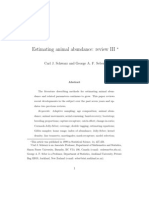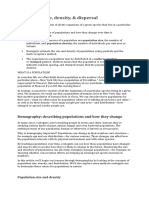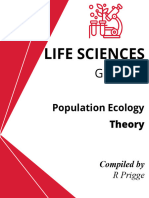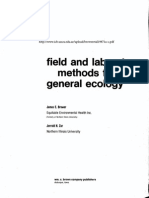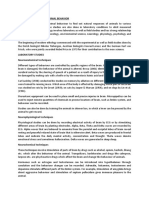Mark Rec103
Mark Rec103
Uploaded by
Alief Tian Edo PramonoCopyright:
Available Formats
Mark Rec103
Mark Rec103
Uploaded by
Alief Tian Edo PramonoOriginal Description:
Copyright
Available Formats
Share this document
Did you find this document useful?
Is this content inappropriate?
Copyright:
Available Formats
Mark Rec103
Mark Rec103
Uploaded by
Alief Tian Edo PramonoCopyright:
Available Formats
Biology 103
A Method of Population Estimation: Mark & Recapture
Objectives: 1. Learn one method used by wildlife biologists to estimate population size of wild animals. 2. Learn how sampling size effects accuracy and standard error of estimates. 3. Use the mark-recapture method to estimate the number of coins in a jar. I. Introduction To understand how different physical or biological factors influence the distribution or abundance of species, we usually need to measure changes in population abundances over space or time. Ecologists interested in questions about populations and communities frequently face a very basic question: how best to estimate the size of a population of organisms in the field? However, it usually is not possible to obtain a complete count or census of a natural population of animals (and it is often difficult even for plants!). For this reason, ecologists generally have to rely on some kind of estimate of abundance or density. A variety of methods exist to do the job; the utility of each varies depending on such factors as the type of organism, the habitat in which the population occurs, and the time and equipment available. The methods ecologists use vary in their level of precision and difficulty of application. At one extreme is a complete census of individually identifiable organisms. This approach might involve tagging all trees in a forest plot, or marking all the animals of a species living in an area at a particular time. Techniques for individually identifying animals include: Compiling a catalog of photographs or drawings that show unique markings of individuals (e.g., fin shape and markings whales; spot patterns on African wild dogs; whisker patterns in lions; facial expressions in primates); Tagging individuals with markers visible from a distance or in the hand (e.g., numbered metal leg bands on birds; colored plastic leg bands in unique patterns on birds; strings of beads around the necks of small primates; wing tags on bats).
At the other extreme are quick & dirty methods that give crude estimates of abundance. Examples include counting all birds sighted along a roadside route one travels by car; counting the number of monarch butterflies passing a point such as Cape May during migration; counting the number of bird songs one hears during a morning in the spring; scanning aerial photographs of wildebeest herds on the African plains; or counting animal tracks along a trail. One may count the number of singing males of a species of bird in a given community or defined area and then estimate the size of the breeding population by assuming that for every male there is one female. Or one may count the individuals in a sample area and then extrapolate to the larger area in which the whole population is assumed to live. Because each method has different assumptions and hence, different strengths and weaknesses, it is recommended (though rarely done) that at least two estimation methods be used and compared in any population study. A variety of methods for estimating population size fall between the two extremes outlined above. These methods involve marking a subset of a population, followed by later counts of the relative numbers of marked and unmarked individuals. This type of method is more precise than a crude census in which no organisms are marked at all, but takes less time and expense than does an exhaustive marking program.
The Mark and Recapture Technique By far the most popular way to measure the size of a population is called the Mark and Recapture Technique. This technique is commonly used by fish and wildlife managers to estimate population sizes before fishing or hunting seasons. The mark and recapture method involves marking a number of individuals in a natural population, returning them to that population, and subsequently recapturing some of them as a basis for estimating the size of the population at the time of marking and release. This procedure was first used by C.J.G. Petersen in studies of marine fishes and F.C. Lincoln in studies of waterfowl populations, and is often referred to as the Lincoln Index or the Petersen Index. It is based on the principle that if a proportion of the population was marked in some way, returned to the original population and then, after complete mixing, a second sample was taken, the proportion of marked individuals in the second sample would be the same as was marked initially in the total population. That is,
R (marked recaptures) T (total in second sample)
M (marked initially) N (total pop. size)
By rearrangement we can estimate the population size, N, to be,
M*T N = R
For example, suppose you took 200 mice out of a forest having an unknown number of mice, put leg bands on them, return them to the forest and let them mix thoroughly. If you then take 250 mice from the forest and find 50 of them to be have leg bands, then M = 200, T = 250, R = 50, and the unknown total number of mice (N) could be estimated as:
N = M*T/R = (200)(250)/50 = 1000 mice
Sample problem: A pest control technician captures and applies ear tags to 23 brown rats, which he then releases. A week later he traps 29 brown rats, 11 of which have ear tags. What is the estimate of the total population of brown rats?
Assumptions: The accuracy of this mark-recapture method rests on a number of assumptions being met. Assumption 1. During the interval between the preliminary marking period and the subsequent recapture period, nothing has happened to upset the proportions of marked to unmarked animals (that is, no new individuals were born or immigrated into the population, and none died or emigrated). Another way to state this assumption is that the population is assumed to be "closed". An exception is when there are equal proportions of deaths or emigrants for marked and unmarked individuals during the sampling period. If deaths occur in this manner the proportions of marked to unmarked will not change and thus we can still estimate the population. Notice the same cannot hold true for births since a proportionate number of individuals will not be born with marks on them. Births can still occur and an accurate estimate can still be made only if an equal number of unmarked individuals leave (or die) and are born. This means that no marked individuals can leave, which would be highly unlikely.
Notice that inherent in this assumption is that the marking of the individuals has no effect on their survival. This is often the most difficult assumption to meet since the mark may make the individual more noticeable to predators or may slow them down, such that more marked individuals die than unmarked between the sampling periods. You should also be aware that the length of the sampling period is very important. The shorter the time interval between marking and recapturing individuals reduces the likelihood that this assumption will be violated. The longer the time interval the greater the chance that some individuals will die, emigrate, immigrate or even be born and hence become an "open" population. Assumption 2. The chance for each individual in the population to be caught are equal and constant for both the initial marking period and the recapture period. That is, marked individuals must not become either easier or more difficult to catch. Marking an individual does not make them more or less likely to be recaptured relative to unmarked individuals. Furthermore, there cannot be something unique about those animals that were initially marked that make them more conspicuous. If only males are captured in the traps because females are busy incubating eggs or feeding, then males may be more likely to be recaptured. Hence the population estimate would only be appropriate for those animals with that unique behavior that make them easier to capture (i.e. males). Another problem deals with 'trap shy' or 'trap happy' individuals. Some techniques for capturing and marking animals can have a dramatic effect on the animal. Trap shy animals quickly learn to avoid those traps or that area where the capture occurred making them less like to be recaptured. The opposite can also occur, especially if the trapping method uses bait. A trap happy individual is lured into a trap with food and is then marked. Later during the recapture period the animal may recall that these traps had rewards (food) and that other than a little decoration (the mark) it made out pretty good. Therefore it becomes trap happy and is more likely to be captured in the trap compared to unmarked individuals who have not experienced the rewards. Also notice that there cannot be any changes in behavior among individuals that may affect capture probabilities. For example, in some species there are different times of peak activity for different classes in the population. Adult males may be most active in the morning. Juvenile males and females may be most active midday, and adult female may be most active in the afternoon. If you mark individuals in the morning you will capture and mark mostly males. But if you perform your recapture sample at midday or the afternoon, you will capture mostly unmarked juveniles or females, respectively. Again, you should realize that the length of time between the sampling periods plays an important role in whether this assumption is violated. Assumption 3. Sufficient time must be allowed between the initial marking period and the recapture period for all marked individuals to be randomly dispersed throughout the population (so that assumption 2 above holds). However, the time period must not be so long that Assumption 1 breaks down. If marked animals failed to disperse from the sampling area, or if they tend to aggregate in groups, there is a higher probability that they will be recaptured relative to unmarked individuals (or not depending on where they aggregate). Assumption 4. Animals do not lose their marks. This is an important factor for animals that shed or molt as they grow or as they respond to seasonal factors. All these assumptions must be considered very carefully and play a strong role in the techniques used to perform the study. A certain method of trapping may violate one assumption while another trapping method may violate another assumption. Having too short of a time interval between sampling may lead to the violations of one assumption (which one(s)?) while an interval that is too long will violate others (which one(s)?).
Clearly the decisions the researcher must make during such a study require an extensive knowledge of the natural history of the organism. Do behavioral patterns change over the day? When do they breed? When does most of their mortality occur? What are their predators? How quickly can they move? Are they territorial? Questions like these must be answered before the experiment is designed and performed so that a minimum of violations to the assumptions are made.
II. Methods -- Your goal is to estimate a population size using the mark-recapture method. You will use an unknown amount of beans as your model population. Each pair of students needs these materials: 1-600 ml Beaker which represents the habitat to be sampled 1-small Beaker (sampling beaker) 1-400 ml Beaker with a known number of white beans 1-400 ml Beaker with colored beans (marked individuals) 1-400 ml beaker (empty, to hold beans removed from the population) Effort 1: 1. Obtain a population of white beans, a large habitat beaker, colored beans, and one small beaker. The white beans will represent the population to be sampled. 2. Marking: Using the small beaker as a trap, push through the white bean population once, filling the trap with beans to the 10 ml line. Count the number of white beans caught and for each white bean caught, substitute a colored bean and record that number as: Number marked = M. (E.g., if you trapped 23 white beans with your sampling beaker you would put 23 colored beans into the original population). 3. Thoroughly mix the marked and unmarked bean population. (Which assumption does this fulfill?)
4. Recapturing: Now sweep through the mixed bean population with the trap once, filling the trap to the 10 ml line. If you recovered at least one colored bean with this sweep, record the number of marked beans (recaptures) as R. Record the total number of beans caught as T, ( i.e. marked + unmarked). 5. Now calculate the bean population size using the formula N = M*T/R
Effort 2: Repeat steps 2, 3, 4, and 5, but this time fill the trap to the 20 ml line at #2 and #4. That is, you will be doubling your sampling effort. Effort 3: Repeat steps 2, 3, 4, and 5, but this time fill the trap to the 30 ml line at #2 and #4. Again, you are increasing your sampling effort.
III. Results In a graph, compare the entire class's mean estimates for population size for each of the three sampling efforts. What happens to each of the parameters listed below when sampling effort is first doubled (10 ml vs. 20 ml) and then increased again by 50% (20 ml vs. 30 ml)?
Mean of the estimates at each 'Effort'
Standard error of the mean of the estimates
Range of estimates
Assuming cost is an issue, which of the three sample sizes would be the best ? (In the sampling of actual wildlife, cost usually is an issue. It can be expensive and time-consuming and laborintensive to sample wild populations. Getting accurate results without consuming to many resources [time, money, possible harassment of animal population] is a worthy goal. )
IV. Conclusion 1. Evaluate how well you were able to satisfy each of the assumptions of the mark-recapture technique.
2. If migration occurred in a natural population being studied, how would this influence the reliability of your estimate of population size determined using the mark-and-recapture technique? Would your population estimate be too high or too low, or would you not be able to predict how your estimate would be biased? (Remember: migration consists of both immigration and emigration.
3. Discuss the kind of bias you would expect to be generated in the estimate of population size (and/or the standard error) if each of the remaining assumptions (2, 3, and 4) were violated. (For example: If Assumption 2 is not met, would it cause the size of the population to be overestimated? underestimated? Or have no effect? ) Note that it is possible that violating several different individual assumptions may have the same effects.
One final statement. There are a number of other models (designs and equations used to estimate population size. Each has their own set of assumptions. They are often grouped into open and closed models depending on whether the population is assumed to be open or closed. There are many modifications of this model that allow one to relax some of the assumptions but typically this requires more sampling effort. But as you can imagine the complexity of the mathematics can greatly increase.
You might also like
- Ecology Chat 2: Population Ecology Teacher Answer Key: Station: Dispersion PatternsDocument17 pagesEcology Chat 2: Population Ecology Teacher Answer Key: Station: Dispersion PatternsTrista Aguilar100% (6)
- Mark Rec103Document6 pagesMark Rec103RadMollyNo ratings yet
- A Review of Estimating Animal Abundance.Document126 pagesA Review of Estimating Animal Abundance.Manish BorahNo ratings yet
- Estimating Wildlife PopulationsDocument10 pagesEstimating Wildlife PopulationskamwebazemarkkNo ratings yet
- Mark Recapture MethodDocument9 pagesMark Recapture MethodAbhishek SonawaneNo ratings yet
- Estimating Animal AbundanceDocument134 pagesEstimating Animal AbundancerkalsiNo ratings yet
- Capture RecaptureDocument2 pagesCapture RecaptureBelinda XianNo ratings yet
- Estimating Population Size, Mark-RecaptureDocument6 pagesEstimating Population Size, Mark-RecapturejaclynNo ratings yet
- Population Ecology Unit 5Document37 pagesPopulation Ecology Unit 5nathnaelNo ratings yet
- Population Size, Density, & Dispersal: Demography: Describing Populations and How They ChangeDocument4 pagesPopulation Size, Density, & Dispersal: Demography: Describing Populations and How They ChangeAllan Jr. Agao-AgaoNo ratings yet
- Estimating Population SizemodDocument6 pagesEstimating Population Sizemodapi-325089664No ratings yet
- BIO 402-The Basics of Population Dynamics NDocument9 pagesBIO 402-The Basics of Population Dynamics NfitzjohnericNo ratings yet
- Biology - Ecology and Food ChainsDocument9 pagesBiology - Ecology and Food ChainsShannen NaraceNo ratings yet
- Population AttributesDocument66 pagesPopulation AttributesAryanNo ratings yet
- Estimating Plant BiodiversityDocument4 pagesEstimating Plant BiodiversityMarkos KumaNo ratings yet
- WJEC GCSE Biology - Biodiversity & The EnvironmentDocument2 pagesWJEC GCSE Biology - Biodiversity & The EnvironmentMegan TaylorNo ratings yet
- Population EcologyDocument3 pagesPopulation Ecologybrightsbrain56No ratings yet
- GE 10 Environmental Science: Prepared By: Marygrace P. Sanopal, LPTDocument17 pagesGE 10 Environmental Science: Prepared By: Marygrace P. Sanopal, LPTVERGIE LAPINIGNo ratings yet
- BehavioralDocument4 pagesBehavioralxingyu92No ratings yet
- BiodiversityDocument16 pagesBiodiversityAyub100% (1)
- Population Growth & RegulationDocument23 pagesPopulation Growth & RegulationJong FriasNo ratings yet
- 4apopulation DynamicsDocument98 pages4apopulation DynamicsJerome FlorendoNo ratings yet
- Catch and Release LabDocument3 pagesCatch and Release Labapi-276987199No ratings yet
- Population EcologyDocument15 pagesPopulation EcologyLyana AhmadNo ratings yet
- Bio 307 General Ecology IIIDocument26 pagesBio 307 General Ecology IIIokonkwojohnchuks1100% (1)
- Variation in PopulationsDocument6 pagesVariation in PopulationsmonkeysaltaccNo ratings yet
- 330 More Sampling MethodsDocument4 pages330 More Sampling MethodsYanuar Ishaq DcNo ratings yet
- BIO2 NotesDocument187 pagesBIO2 NotesAshley WilliamsonNo ratings yet
- Chapter 2a. Population Characteristics 1Document48 pagesChapter 2a. Population Characteristics 1nagenius7No ratings yet
- Exercise No. 4 - EnS53-Terrestrial Ecology by Hershell Ketash CapaciteDocument10 pagesExercise No. 4 - EnS53-Terrestrial Ecology by Hershell Ketash CapaciteHERSHELL KETASH CAPACITENo ratings yet
- Population Ecology Learning ObjectivesDocument2 pagesPopulation Ecology Learning Objectivesmairashah2004No ratings yet
- 53 - Detaillectout Pop - EcologyDocument15 pages53 - Detaillectout Pop - EcologyDigna ClaveriaNo ratings yet
- Gr11 Population-Ecology TheoryDocument12 pagesGr11 Population-Ecology TheorychulumancokolelaNo ratings yet
- BcchlableoDocument14 pagesBcchlableoapi-424170693No ratings yet
- Ecology Prac-1Document9 pagesEcology Prac-1tariNo ratings yet
- Notes CHP 8Document11 pagesNotes CHP 8tania.burhanNo ratings yet
- Field and Laboratory Methods For General Zoology PDFDocument10 pagesField and Laboratory Methods For General Zoology PDFmizzakee0% (1)
- K Development Team: Zoology Principles of Ecology Life Table, Fecundity Table and Survivorship Curves, Part-IDocument17 pagesK Development Team: Zoology Principles of Ecology Life Table, Fecundity Table and Survivorship Curves, Part-IIlham ArfiansyahNo ratings yet
- Methods of Studying Animal BehaviorDocument21 pagesMethods of Studying Animal BehaviorAntesh100% (1)
- Probability Statistics AdvancedDocument282 pagesProbability Statistics AdvancedAvtansh AgarwalNo ratings yet
- BIOB50 Lecture 4 NotesDocument23 pagesBIOB50 Lecture 4 Notesjoylin2023No ratings yet
- Ecosystems, Sampling and Population StudiesDocument7 pagesEcosystems, Sampling and Population Studiesjohn100% (1)
- Prac 2 SpeciesDocument8 pagesPrac 2 SpeciesDaniel OthmanNo ratings yet
- Practical 2 SpeciesDocument8 pagesPractical 2 SpeciesFatin KhairNo ratings yet
- Biology (Form 3)Document72 pagesBiology (Form 3)Gershom PhiriNo ratings yet
- Bio 1 AzootripDocument11 pagesBio 1 AzootripThaisMayaAguilarNo ratings yet
- Lab04 PDFDocument4 pagesLab04 PDFShweta SridharNo ratings yet
- Volume 42 1 97 3simpanzeDocument9 pagesVolume 42 1 97 3simpanzeAnindyaMustikaNo ratings yet
- Seasonality, Developing Time and Protandry in Three Populations of The Neotropical Grasshopper Sphenarium Histrio in An Altitudinal GradientDocument21 pagesSeasonality, Developing Time and Protandry in Three Populations of The Neotropical Grasshopper Sphenarium Histrio in An Altitudinal GradientVíctor RamirezdNo ratings yet
- Ecology Study GuideDocument18 pagesEcology Study Guidescienceguy10No ratings yet
- Ahmad CDocument11 pagesAhmad Cbz.15 m.13No ratings yet
- Bio MadDocument94 pagesBio MadEvrich WatsonNo ratings yet
- Biology Lab Report 10 (Ecology)Document22 pagesBiology Lab Report 10 (Ecology)Muhamad Aleiff Bin Tajuddin100% (1)
- Mann-1999-Marine Mammal ScienceDocument21 pagesMann-1999-Marine Mammal ScienceLUCAS GARCIA MARTINSNo ratings yet
- JK Black Shaw Whole BookDocument102 pagesJK Black Shaw Whole BookMartha Isabel100% (1)
- 2024 Population Ecology LearnerDocument55 pages2024 Population Ecology LearnerfanelemakayeNo ratings yet
- Captivity Effects On Wide-Ranging CarnivoresDocument2 pagesCaptivity Effects On Wide-Ranging CarnivoresMiguel LessaNo ratings yet
- Odd Couples: Extraordinary Differences between the Sexes in the Animal KingdomFrom EverandOdd Couples: Extraordinary Differences between the Sexes in the Animal KingdomNo ratings yet





